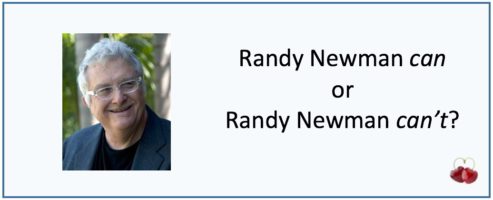39 – Randy Newman can or can’t
I am a big fan of Randy Newman. I have been since my late teens when I first saw him on BBC television (black and white I seem to remember). For those of you who don’t know him, he is the composer of ‘You’ve got a friend in me’ and the music for Toy Story, and he has been nominated for an Oscar twenty times, and won twice (a poor success rate, which amuses him greatly). Outside of writing for films, his songs are renowned for their dark lyrics (the persona of the song is often a very unpleasant character) and bitter-sweet melodies and instrumentation/orchestration. He recently recorded an interview with the BBC (you can download the podcast from here) which I listened to with great glee.
Because I am working on a book about listening (A Syllabus for Listening: Decoding) I tend to listen not only to the content, but also to how people say things. And it dawned on me that there was one part of the interview where I was not sure what Randy said.
Listen to this sentence, where he is giving the second half of an answer from an audience member about advice he would give to young songwriters. Does he say can or can’t?
And … in terms of writing I xxxxx give you advice
I had at first thought that he was saying can’t. In the immediate context, he does go on to give advice, but I thought that this was a kind of humble disclaimer – a move that many people use as a prelude to giving advice (often in the form ‘I’m not sure I’m the right person to give you advice but …’). But on re-listening, I thought that it actually could be can. So I did a quick survey of colleagues in a discussion group which specialises in pronunciation. Eighteen people responded and ‘voted’:
- Eleven people ‘voted’ for can
- Six people ‘voted’ for can’t
- One person ‘voted’ for don’t know (‘stumped’)
So experts disagreed on what he actually said. When this kind of thing happens, I always think that we have an insight into something important. As I said, my interests these days are in the teaching and learning of listening, and so what is of concern to me is what teachers and (especially) learners make of the stream of speech as they listen and re-listen to it in the classroom. My experience is that it is possible for there to be different reasonable hearings of many stretches of speech. In the case of Randy Newman’s example it seems to me that both can and can’t are reasonable hearings of the sound substance.
And when learners comment ‘Oh I cannot tell when Americans/Scots are saying can and can’t’ – they have made a judgement that to their ears, the two things (such as can and can’t) sound the same – and often they are right, as far as the sound substance is concerned! But being expert listeners we ignore the mushy characteristics of the sound substance and allow our certainty of what was meant to shape our perceptions of what we have heard. We are deaf to the indeterminacy, the in-between-i-ness of the sound substance. For teaching decoding, we need to allow for the fact that opposites may sound the same: we need – to be effective teachers of listening – to be undeaf to these happenings.
Even when we – the teachers – are certain what meanings were conveyed , and we are certain what words were intended, the sound substance may well – with justification – be heard to be contrary to both of our personal certainties. Even when we believe that the occurrence of a word in the context of the recording is ‘impossible’, its sound shape may be present – our expertise as a native listener, or our status as an expert listener (expert=you know what the words are) may deafen you to the fact that the sound shape may be hugely at variance with your expectations.
Amongst the comments I received from colleagues about this ‘survey’ were two of particular interest. The first was from Professor John Levis of Iowa State University who wrote …
…given that the succeeding context has him giving advice … “can” makes the most sense, but the phonetic output alone seems ambiguous.
And Helen Fraser from Australia and creator of the Rethink Speech website wrote …
In some ways this is, to my mind, the most interesting thing of all: how often unresolvable ambiguity occurs in speech, usually unnoticed by conversation participants.
Lastly, on this page, you can hear different cans and can’ts from other parts of the same interview.
Photograph of Randy Newman by Robb Bradley from here



Leave a Reply